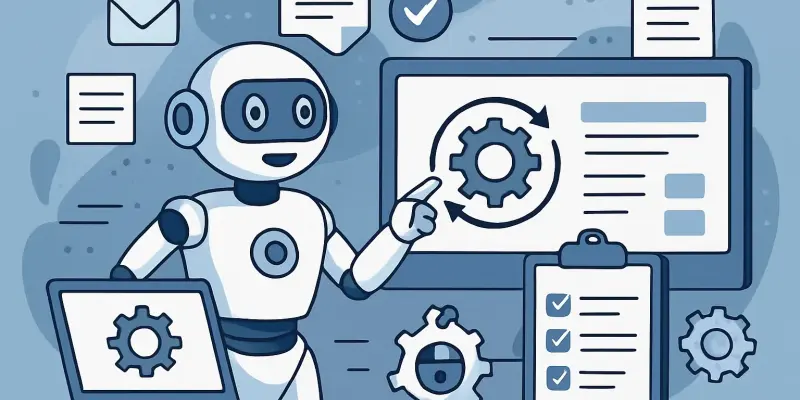Robotic Process Automation: Redefining Workplace Roles
Businesses today face a rapidly evolving technological landscape, where efficiency and innovation are more crucial than ever. Within this dynamic environment, Robotic Process Automation (RPA) has emerged not just as a technological advancement but as a vital component in redefining workplace roles and responsibilities. RPA is not merely an upgrade to conventional automation techniques; it is a transformative force capable of altering the fabric of operational structures, enabling businesses to adapt to unusual times and complexities with agility and precision. Rather than supplanting human workers, RPA serves to collaborate with them, freeing employees from mundane and repetitive tasks. As a result, they can redirect their focus and energy toward strategic and insightful work that impacts the organization’s growth and sustainability. Exploring how RPA reshapes business roles can offer a deeper understanding of its potential to empower individuals and streamline operations in modern enterprises.
Technological Foundation and Integration
The essence of Robotic Process Automation lies in its ability to perform deterministic tasks with high accuracy, mimicking human actions through sophisticated software robots. Operating through graphical user interfaces, these bots alleviate the need for complex backend integration processes traditionally required by automation solutions. RPA provides a user-friendly platform for various industries to incorporate automation into existing systems without overhauling entire infrastructures. This compatibility with legacy systems allows companies to benefit from automation almost immediately, maximizing efficiency and resource allocation. Therefore, in the technological integration context, RPA acts more as an enabler than a disruptor, leveraging existing technological ecosystems for seamless process automation. Critical to this integration process is a well-defined implementation strategy. Organizations adopting RPA must prioritize identifying processes suitable for automation while establishing strong governance frameworks. Aligning automation strategies with broader organizational goals ensures that the deployment of bots enhances operational efficiency and coherence. Measuring success through clear metrics such as task completion rates and process quality helps in understanding the tangible impacts of RPA on productivity and strategic alignment.
Industry-Specific Transformations
RPA’s transformative potential finds a solid foothold in industry-specific applications, particularly in sectors dealing with high-volume repetitive processes. For example, in the finance sector, RPA has revolutionized operations by streamlining invoice processing and account reconciliation. It automates data extraction and error correction processes, improving accuracy and compliance while reducing manual bottlenecks. The result is not only faster turnaround times but also improved transparency and audit readiness, crucial for safeguarding trust and governance in the financial domain. Likewise, in healthcare administration, RPA seamlessly bridges data across platforms while ensuring data security and privacy. Automation in this field has significantly improved operational efficiency, particularly in claims processing and paperwork management. Bots validate eligibility and reconcile numerous transactions quickly and accurately, drastically reducing the time it takes to respond to patient inquiries and process claims. Consequently, healthcare providers can deliver better patient experiences and higher standards of care. These examples illustrate RPA’s capacity to manage intricate process landscapes while adhering to strict regulatory requirements.
Overcoming Implementation Challenges
While RPA offers a compelling value proposition, its deployment is not without challenges. Integration with legacy systems often requires sophisticated bot configurations, posing technical hurdles. Despite these challenges, the relatively non-intrusive nature of RPA—aligning with existing systems without significant disruption—serves as a considerable advantage. Cultural resistance among employees is another significant challenge that can stall automation initiatives. Concerns about job displacement often lead to hesitancy and pushback from staff, necessitating transparent communication and reskilling initiatives. Organizations that emphasize personal development, fostering an inclusive and forward-thinking environment, are more likely to overcome these obstacles smoothly. A systematic approach to process design is also indispensable for successful RPA adoption. By leveraging techniques like process mining, inefficiencies can be identified and addressed, ensuring readiness for automation. Standardizing processes facilitates smoother automation journeys, setting the stage for high-functioning, scalable automation solutions. Hence, businesses equipped to navigate these challenges can unlock unprecedented efficiency and innovation through RPA.
Evolving Business Roles and Human-Automation Synergy
RPA’s influence extends beyond operational efficiency, transforming how human capital is allocated and utilized within an organization. Rather than replacing human roles, RPA augments them by shifting focus away from routine tasks to more analytical and impactful responsibilities. Employees can now engage more meaningfully with their work, pursuing initiatives related to quality improvement, customer engagement, and strategic decision-making. This shift not only enhances job satisfaction but also contributes to a more agile and dynamic workforce. Training and reskilling programs supplement this transition by equipping employees with the skills needed to adapt to their evolving roles. Emphasizing continuous learning ensures that staff remains an essential part of the innovation process, capable of maximizing the potential of RPA implementation. As businesses continue leveraging human-machine synergy, RPA becomes an integral contributor to organizational culture. It embodies a shift from automating labor-intensive processes to embracing technology as a partner, driving strategic initiatives and amplifying human contributions.
Future Outlook and Strategic Integration
Robotic Process Automation (RPA) excels at executing deterministic tasks with high precision, emulating human behaviors through advanced software bots. These bots operate via graphical user interfaces, negating the necessity for intricate backend integrations that traditional automation approaches often demand. RPA presents an intuitive platform, enabling diverse industries to integrate automation into their existing systems without revamping entire frameworks. Its compatibility with legacy systems allows companies to immediately gain from automation, optimizing both efficiency and resource allocation. Therefore, in the realm of technological integration, RPA serves as an enabler rather than a disruptor, enhancing existing technological environments for smooth automation processes. Crucial to this integration is a thought-out implementation plan. Businesses embracing RPA must prioritize identifying automation-worthy processes and establish strong governance. Aligning automation strategies with wider organizational objectives ensures that deploying bots bolsters operational efficiency. Clear metrics, like task completion rates and quality, are essential to gauge RPA’s impact on productivity and alignment.

